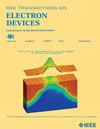Comprehensive Study of Low-Frequency Noise Origins in Scaled Atomic-Layer-Deposited IGZO TFTs
IF 2.9
2区 工程技术
Q2 ENGINEERING, ELECTRICAL & ELECTRONIC
引用次数: 0
Abstract
In this work, we investigate the 1/f noise, i.e., low-frequency noise (LFN), characteristics of scaled atomic-layer-deposited indium-gallium–zinc oxide (IGZO) thin-film transistors (TFTs) focusing on key factors such as: 1) varying indium (In) concentrations; 2) post-thermal annealing; and 3) channel length (尺度原子层沉积IGZO tft中低频噪声源的综合研究
在这项工作中,我们研究了缩放原子层沉积铟镓锌氧化物(IGZO)薄膜晶体管(TFTs)的1/f噪声,即低频噪声(LFN)特性,重点关注以下关键因素:1)不同的铟(In)浓度;2)热后退火;3)通道长度(${L}_{\text {ch}}\text {)}$缩放。将In比从2:1:1增加到7:1:1可以提高场效应迁移率($\mu _{\text {FE}}\text {)}$从11.2 cm2/V增加到36.6 cm2/V),并减少LFN高达85%, demonstrating the role of In content in improving both electrical performance and noise characteristics. Post-annealing further mitigates LFN, achieving reductions of up to 68%, depending on the IGZO compositions. As ${L}_{\text {ch}}$ scales down, the dominant LFN mechanism shows a tendency to shift from mobility fluctuations ( $\Delta $ $\mu $ ) in long-channel devices ( ${L}_{\text {ch}} = 1~\mu $ m) to carrier number fluctuations ( $\Delta $ n) in short-channel devices ( ${L}_{\text {ch}} =50$ nm), as indicated by the distinct dependence of normalized drain-current power spectral density ( ${S}_{\text {ID}}$ / ${I}_{\text {D}}^{{2}}\text {)}$ on gate overdrive voltage. This behavior, supported by LFN measurements at elevated temperatures ( $\sim 125~^{\circ }$ C) and bias temperature instability (BTI) analyses, highlights the increasing influence of near-interface traps in scaled devices.
本文章由计算机程序翻译,如有差异,请以英文原文为准。
求助全文
约1分钟内获得全文
求助全文
来源期刊

IEEE Transactions on Electron Devices
工程技术-工程:电子与电气
CiteScore
5.80
自引率
16.10%
发文量
937
审稿时长
3.8 months
期刊介绍:
IEEE Transactions on Electron Devices publishes original and significant contributions relating to the theory, modeling, design, performance and reliability of electron and ion integrated circuit devices and interconnects, involving insulators, metals, organic materials, micro-plasmas, semiconductors, quantum-effect structures, vacuum devices, and emerging materials with applications in bioelectronics, biomedical electronics, computation, communications, displays, microelectromechanics, imaging, micro-actuators, nanoelectronics, optoelectronics, photovoltaics, power ICs and micro-sensors. Tutorial and review papers on these subjects are also published and occasional special issues appear to present a collection of papers which treat particular areas in more depth and breadth.
 求助内容:
求助内容: 应助结果提醒方式:
应助结果提醒方式:


